What you need:
- A pack or two of ruled 3X5 index cards (we tried using completely blank index cards, but we found that the kind that are ruled on one side made it easier to distinguish between the front and the back of the deck)
- A pen for each player
- Your card reserve (if you have one)
The Deck:
We usually play with a deck of 60 cards for 4 or 5 people, and a deck of 90 cards for 6 people or more. The main thing is for the deck to be divisible by three, and then again by the number of players. This will make more sense in a minute.
- 1/3 of the cards should be blank
- 1/3 of the cards should be made in the pre-game phase
- 1/3 of the cards should be chosen from the reserve (if you have no reserve, double the number that each person has to make in the pre-game phase)
Pre-Game Phase:
This is where that weird "deck divided by three divided by the number of players" number comes in. If you're playing with a 60-card deck and 5 players, for example, this number would be 4. Let's call this number X, according to mathematical convention.
- Place the blank third of cards face-down in the middle (the blank side is the "face", in case you were wondering).
- Pass around the reserve deck and let everyone choose X cards that they like. Place them face down in the middle on top of the blank cards. If any of your guests have played this game before, they may have reserve decks of their own to choose from, if not, then just let everyone choose from yours.
- Give everyone X more blank cards to make. As they finish their new blank cards, they may add them to the deck on top of the blank and reserve cards. Shuffle the deck well once all the cards have been added.
- Assign a scorekeeper and give him or her an extra blank card to keep score on.
Game Play:
- Deal out five cards to each player. Leave the rest of the cards face-down in the middle as a draw pile. The player to the left of the dealer plays first.
- On your turn, you play a card. You may play a card on yourself, on someone else, or in the middle of the table on everybody. Cards may have points, effects, rule variants, or any number of things on them, limited only by the creativity of the players. Once the card's effect is completed, the card is placed face-up in a discard pile beside the draw pile.
- At the end of your turn, you draw a card (or cards) to return the total number of cards in your hand to five. Play continues to the left.
The Anatomy of a Card:
- The basic blank white card consists of three parts: a title, a drawing, and a point value. For example, you might make a card called "Cute Little Puppy," underneath which you might draw a puppy, underneath which you might write, "+300 points." I don't have any scans of this kind of card, because it's boring, but these boring cards are essential to game play moving along at something more than a snail's pace. Of course, your basic cards don't have to be boring. You could draw a "Cute Little Puppy OF DEATH" card, for example. You might want to give him negative points, though.
- You can make cards that assign points creatively, too. Or unfairly, if you choose to make a card like my "Blatant Sexism" card that is worth positive points to females and negative points to males. (I usually play this card in the middle so that all of the males lose points and all of the females gain points.)
- Generally, we tend to make point values in increments of 100, ranging from -500 to +500. But, like most rules of the game, this one gets bent a lot.
- Some cards might alter the game play, like reversing the direction or changing the hand limits. These new rule variants will remain in effect unless another card comes along and changes them.
- Some cards have longer effects and need to remain on the table until they are discarded, either due to an internal limitation, or another card removing them.
- Some cards might tell you to do things that have nothing to do with the game. Do them. If you don't, you're no fun. And why would you want to play this game if you don't want to have fun?
- If there is a question about how to interpret a particular card, the final decision lies with the person who made the card. If necessary, and if everyone agrees, they can add a clarifying phrase to the card when the rule comes into question.
The Blank Cards:
- One third of the cards in your deck are blank. These cards are the great equalizers. There is no rule preventing you from making a card that says, "From now on, every card that gives points gives them to Jule Ann, and every card that takes away points takes them away from Jeremy." You could do that, but don't forget that there are blank cards in the deck. Jeremy could make a card that discards my card and reverses our points. Not to mention that, if I made a card like that, I would annoy a lot of people, and would probably be the target of every negative point card for a good, long while.
- If one of the cards in your hand is blank, you may draw on it at any time to make it into a playable card. The general rule is that you can only be making new cards when it's not your turn, but in actuality, we often end up waiting for someone to finish a card on their turn before they play it. You can decide how strict you want to be about this rule. If we know someone is probably making a card that will undo the effects of a really annoying card, then we might be more forgiving of a few minutes delay while they finish it. Or, if they only have blank cards in their hand, we might also be patient with them while they make one of them into a playable card.
- You can only draw on blank cards. You can't change a card that has already been completed unless the card, or another card, tells you that you can.
- Once there are no cards left in the draw pile, the game pauses for a few minutes while everyone finishes making any blank cards they are still holding in their hands. This prevents people from holding onto a blank card until the very end and making it at the last minute to win them the game. Of course, you can still hold onto a pre-drawn card that will win you the game at the last minute, but you'd be surprised how often that doesn't end up working out.
Game End:
- The game continues until no one can play any more cards. If you are out of cards, or all of the cards that remain in your hand are unplayable (for example, if the card explicitly says, "you may not play this card"), you must pass, and the play will continue until everyone passes.
- The winner is the person with the most points at the end of the game.
- After you are done playing, sort the cards into piles according to who drew them. In order to make this step of the process easier, we ask everyone to put their initials on the cards they made. Everyone takes home their own cards. This serves two useful purposes: First, it allows the game to spread exponentially like that monster dough stuff, because everyone now has their own reserve deck to play with. Second, the next time I play, I understand all of the cards in my deck, because I made them. It's really annoying to have a question about how to interpret a card in an unexpected situation when the original card-maker is not there to clarify his or her intent.
- Keep your cards as a reserve deck for the next time you play. Some people sort through and only keep the best ones, discarding the others, but I keep them all. My reserve deck is huge, and some of the cards are meaningless without the cards they were originally designed to counteract, but that's half the fun of the reserve deck to me. It's like a journal of past games.
Some Sample Cards:
The other half of the fun of the reserve deck is showing off the cards you've made in the past. It also helps new players to get a feel for what sorts of cards they can make, which is why I have new players choose their X number of cards from my reserve deck before they have to create X of their own cards out of thin air. So, without further ado, here are a few of the cards I have kicking around in my reserve deck:
Basic points card with a bit of a twist

More fun with points
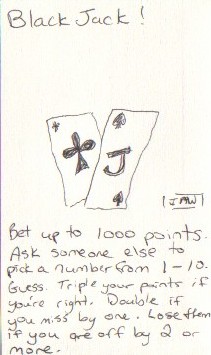
Pointless, silly card

Situation-specific card from law school (and yes, I made the scorekeeper keep track of stress points, sleep points, and brain cells separately on the score card)

A fun one that just keeps coming back around
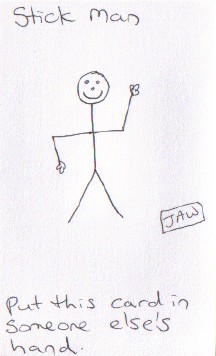
This one prompted the "Say 'pig' or lose 10,000 points" card
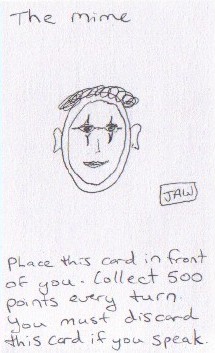
I still don't understand how this card has yet to get folded up
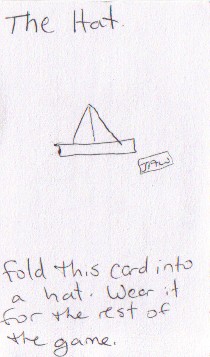
The best card my husband ever made
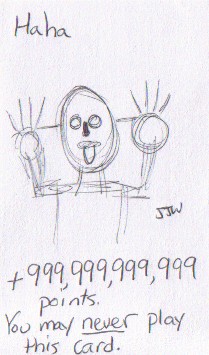
My personal favourite
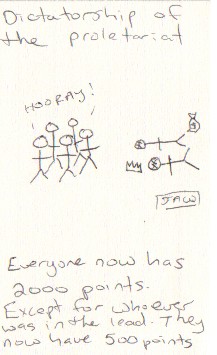
1 comment:
I'm so glad you posted about a game, because I'm commenting here to let you know that you're about to play a game! I've tagged you to play word association! (My condolences.)
As for Blank White Cards, it looks like it could be plenty of fun -- with the right people. I'm sure the game can be quite lousy with a bunch of boring or not-in-the-mood folks.
If I were to rename it, I'd call it "Poor Man's Magic: The Gathering."
Post a Comment